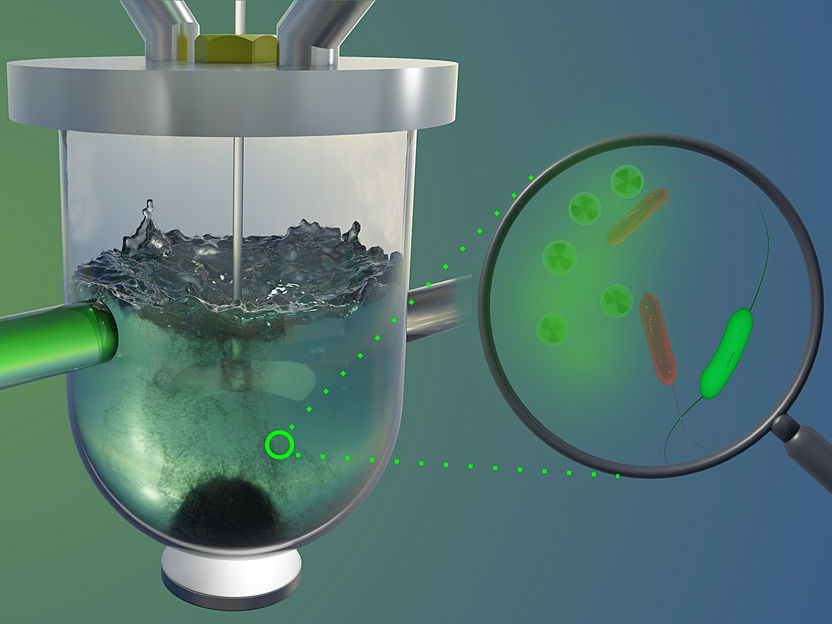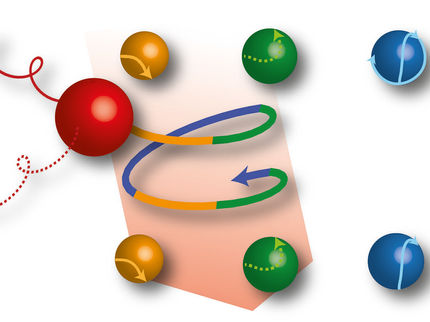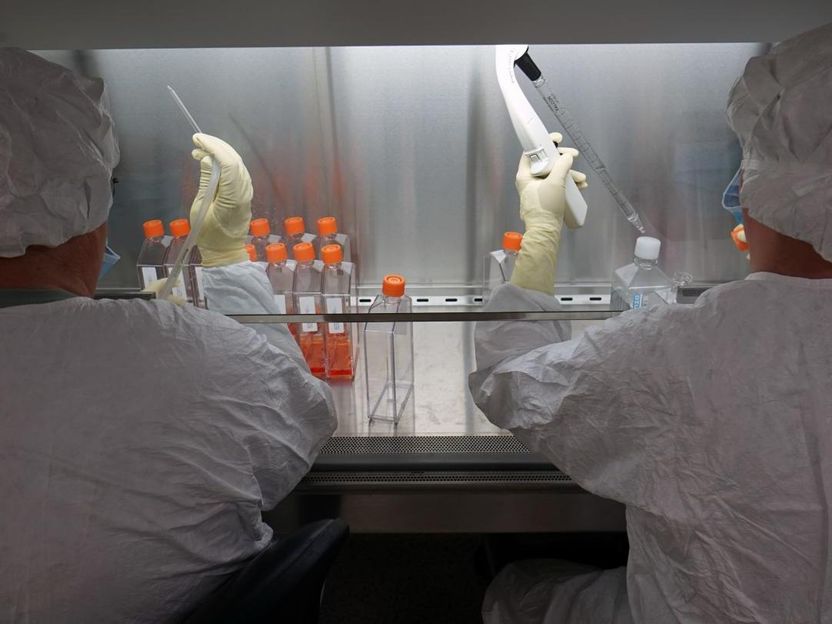Magnetic bacteria can help to extract dangerous heavy metals from wastewater
Filigree sewage plants
A research team at the Helmholtz-Zentrum Dresden-Rossendorf (HZDR) has managed to purify water containing uranium using a special kind of bacteria known as magnetotactic bacteria. The name derives from their ability to react to magnetic fields. They can accumulate dissolved heavy metal in their cell walls. These research findings also shed new light on the interaction between uranium and bioligands.

Magnetotactic bacteria bind uranium in their cell wall (schematically shown on the right). This can be used to purify uranium-contaminated water by separating the loaded bacteria with a magnet (shown on the left).
B. Schröder/HZDR
“Our experiments are geared towards potential industrial applications in the field of microbiological remediation of water, especially when it is contaminated with heavy metals of the type you find in mine drainage water in the old uranium mines,” explains Dr. Evelyn Krawczyk-Bärsch of HZDR’s Institute of Resource Ecology. “For this project we sought help from a very special group of living creatures: the magnetotactic bacteria,” her colleague, Dr. Johannes Raff, adds and continues, “Due to their structure, they are positively predestined for such a task.”
Because they exhibit a feature that differentiates them from other bacteria: magnetotactic bacteria form nanoscopic magnetic crystals within the cell. They are arranged like a row of beads and so perfectly formed that humans would currently be unable to reproduce them synthetically. Each individual magnetic crystal is embedded in a protective membrane. Together, the crystals and membrane form the so-called magnetosome which the bacteria use to align themselves with the Earth’s magnetic field and orientate themselves in their habitat. It also makes them suitable for simple separation processes.
Magnetotactic bacteria can be found in almost any aqueous environment from fresh water to saltwater, including environments with very few nutrients. Microbiologist Dr. Christopher Lefèvre has even discovered them in the hot springs of Nevada. It was from him and his colleague Dr. Damien Faivre of the French Alternative Energies and Atomic Energy Commission (CEA) that the Rossendorf scientists acquired their bacteria strain, not to mention expert advice on how best to preserve them – because despite being fairly common, cultivating them requires some specialist knowledge.
Stable heavy metal collectors in a hostile environment
Magnetotactic bacteria can survive at neutral pH values, even in aqueous solutions containing higher concentrations of uranium. Over a wide pH range, they bind the uranium almost exclusively in their cell walls – an excellent basis for dealing with the conditions found in water associated with mining. None of the uranium penetrates into the interior of the cell in the process, nor is it bound by the magnetosome.
It was already known that different types of bacteria could bind heavy metals in their cell walls despite being potentially quite differently structured. In the case of magnetotactic bacteria the cell walls are formed of a peptidoglycan layer, a macromolecule composed of sugars and amino acids which is the main component of the cell walls of many bacteria, which is only four nanometers thick. The cell walls of magnetotactic bacteria are surrounded by an external membrane composed of sugars and fat-like components: potential docking sites for uranium.
“Our results show that in magnetotactic bacteria peptidoglycan plays the main role in absorbing uranium. This knowledge is new and unexpected in this type of bacteria,” says Krawczyk-Bärsch. The team even managed to identify three specific uranium peptidoglycan species and confirm their findings with reference samples. These new insights were only possible thanks to a combination of microscopy and various spectroscopic techniques, a combination that is rarely found anywhere else in the world. “By cooperating with the Institute of Ion Beam Physics and Materials Research at HZDR, for example, we were able to use the electron microscope. The proximity of our institutes at the site and the expertise of our colleagues are a major advantage for our work,” Raff summarizes.
Significance for purifying contaminated water
Thanks to their magnetic properties, magnetotactic bacteria can be easily separated from water using magnets. “It’s conceivable this could be done on a large scale by carrying out the treatment right in the surface water or by pumping water from underground mines and directing it to pilot treatment plants,” Krawczyk-Bärsch explains with an eye to developing innovative purification strategies for contaminated water. Using magnetotactic bacteria could be an effective alternative to expensive, conventional chemical treatments – because magnetotactic bacteria are undemanding in terms of upkeep; implementing other biomass-based solutions, by contrast, regularly fails due to the costs involved in increased nutrient and energy requirements.
And another detail has sparked the researchers’ interest in these bacteria: their proteins can stabilize divalent and trivalent iron so that the magnetite stored in the magnetosomes can be synthesized. “So, we are really asking ourselves how these microorganisms interact with radionuclides in various oxidation states. In particular, we are thinking of plutonium,” explains Raff. This is because, unlike uranium, it is conceivable that its chemical similarity to iron means it uses other routes into the cell. How does this influence the migration behavior of plutonium in nature, and could this also be a way of removing plutonium from wastewater? Thus, the topic is also of relevance to repository research: any results could then be incorporated into the safety assessment.
























































